At this moment in time, an ethical AI PR agency framework needs to be on the mind of every PR professional. As you ask yourself, “How can AI be used in PR?” you also need to ask how your team will use it in a way that’s both fair and transparent.
Thankfully, the industry is quickly creating guidelines to address this important matter. We’ll walk you through the latest PR and AI industry stances.
- How does AI impact PR agencies?
- What are the PR Council Guidelines on generative AI?
- Understand your generative AI tools & goals first
- How exactly can you use AI in your PR agency?
- How to introduce an ethical AI framework to a PR agency?
- Questions any AI PR agency should answer
- Start using AI responsibly
If you’re in a rush, don’t craft press releases from scratch. Create an AI-generated press release, and find the right journalist to pitch using Prowly's AI suggestions.
How does AI impact PR agencies?
AI in public relations is highly beneficial. It allows PR professionals to automate first-draft tasks like press release writing and media contact list creation. This gives them more time to dedicate themselves to higher-level PR strategy work and helps them overcome writer's block.
The uses of AI in PR agencies
PR agencies are already using AI in these ways:
- Researching the best-matched journalists and influencers for upcoming campaigns.
- Creating first drafts of press kit materials like press releases and company bios.
- Gathering information about competitors.
Concerns around AI in public relations
There are, of course, some concerns about using AI for communications and media industries (outside of “Will AI replace PR professionals?” That’s a discussion for another day).
The top concerns are:
📛 Keeping client data confidential
📛 AI tools including outdated or false information
📛 Having PR pros not edit, update, and closely revise Artificial Intelligence results, skipping a significant need for that human touch
Let’s take a look at the ways to introduce an AI change successfully in any PR agency, based on ethical and legal advice.
What are the PR Council Guidelines on generative AI?
As PR agencies and teams have struggled with creating their own generative AI framework of detailed policies and guidelines, professional organizations like the PR Council have jumped in to create generative AI frameworks that PR teams can easily reference and adopt.
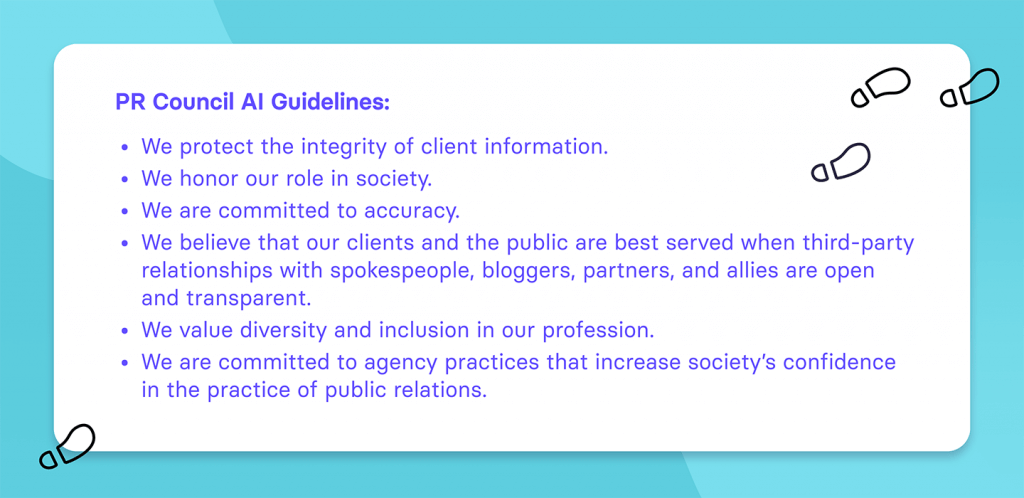
In the case of the PR Council, their high-level guidelines include:
- We protect the integrity of client information.
- We honor our role in society.
- We are committed to accuracy.
- We believe that our clients and the public are best served when third-party relationships with spokespeople, bloggers, partners, and allies are open and transparent.
- We value diversity and inclusion in our profession.
- We are committed to agency practices that increase society’s confidence in the practice of public relations.
Each of these guidelines is broken down further into discreet examples. We’ll hit on some of those here, but we highly recommend you read their full guidelines and watch their accompanying video.
You can also watch on-demand videos from our latest PR Episodes event, where industry experts discussed data-driven PR and AI, and shared their experiences.
Understand your generative AI tools & goals first
So, where to begin with AI, if you haven’t started already?
#1 Get to know the PR AI tools available on the market
First, get to know the AI tools that are available and establish what you want to achieve using them. Host a brainstorming session and ask your agency members how AI could help them complete their workflow tasks.
#2 Check data privacy
Second, research who created each tool and how they store data used for prompts.
This is critical to protecting any data you include in your research prompts.
#3 Check AI tools features and choose a solution for yourself
Then, narrow in on the AI tools that work best for PR pros. You can choose to use a few tools or try an all-in-one solution to omit extra steps, like creating prompts for ChatGPT.
How exactly can you use AI in your PR agency?
Can PR be automated using AI? Yes!
💬 Aleksandra Kubicka, PR Evangelist @Prowly:
"We have made using AI easier with pre-made prompts, so users don't need to do it alone and go through trial and error to determine what works and what doesn't. The AI algorithms are trained not to act like a simple writing tool, but rather like a writer with years of experience in public relations."
Here’s what AI can do to make PR pros’ work easier, based on Prowly’s PR software platform:
👉🏼 Generating press release drafts
Our new AI-powered Press Release Creator can create an impressive first draft press release for you through a natural conversational flow. The tool delivers the foundations of a press release that you can then refine and finalize.
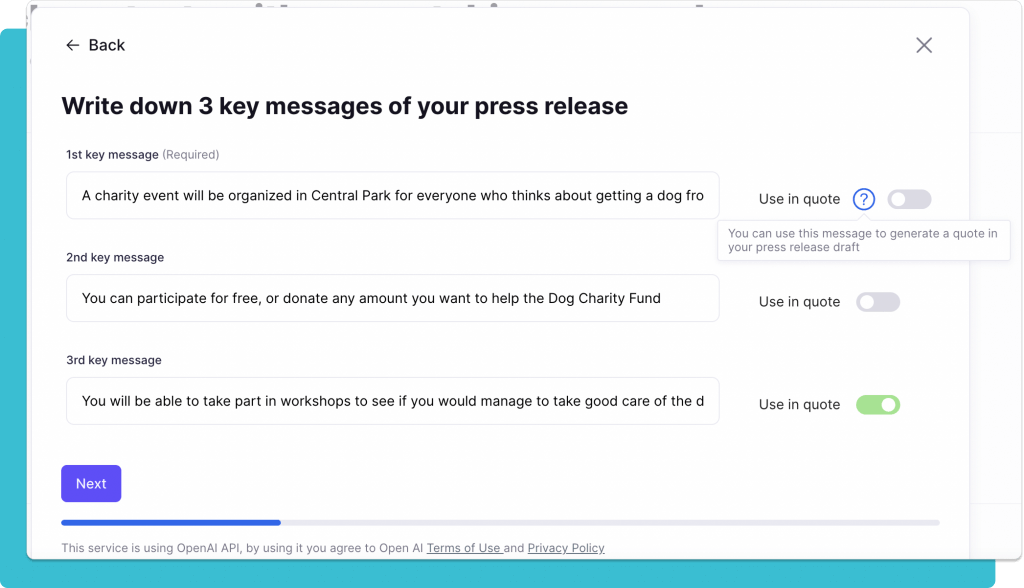
We prepared two guides on using the AI Press Release Generator, as well as writing press releases and pitching them with AI, to walk you through the best practices.
👉🏼 Recommending relevant journalists & media
Based on the content of your press release, Prowly Artificial Intelligence will instantly suggest journalists who might be interested in your story and then helps you create an email pitch with a catchy subject line and preview.
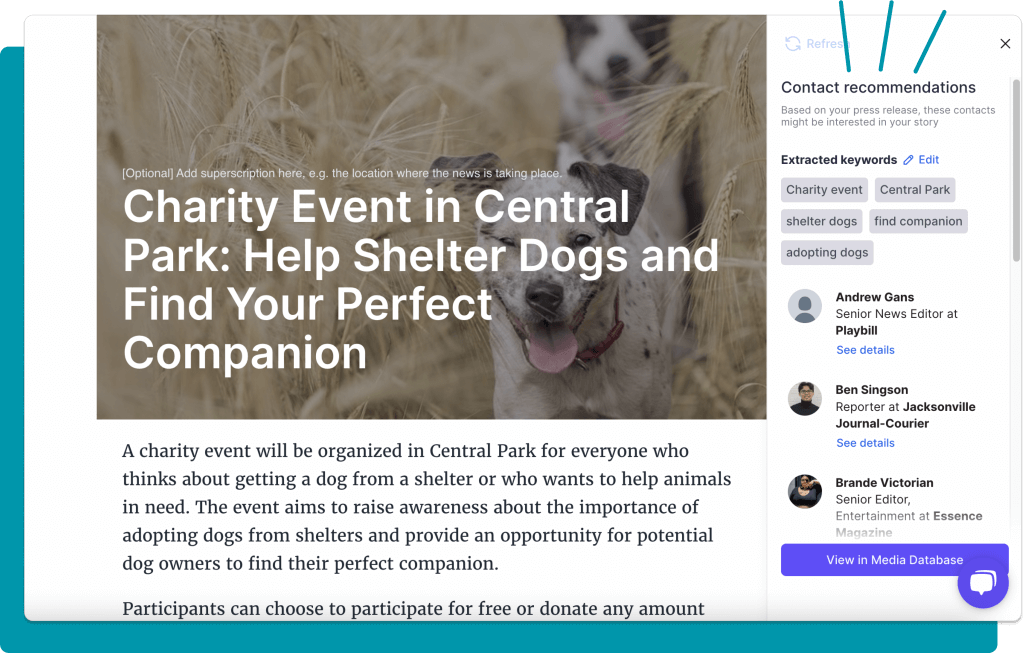
👉🏼 Writing a pitch draft
Prowly's pitch generator is like your trusted assistant for crafting pitch drafts. Based on your press release, AI generates a preliminary pitch. You can then refine it to align with your standards, saving time and effort.
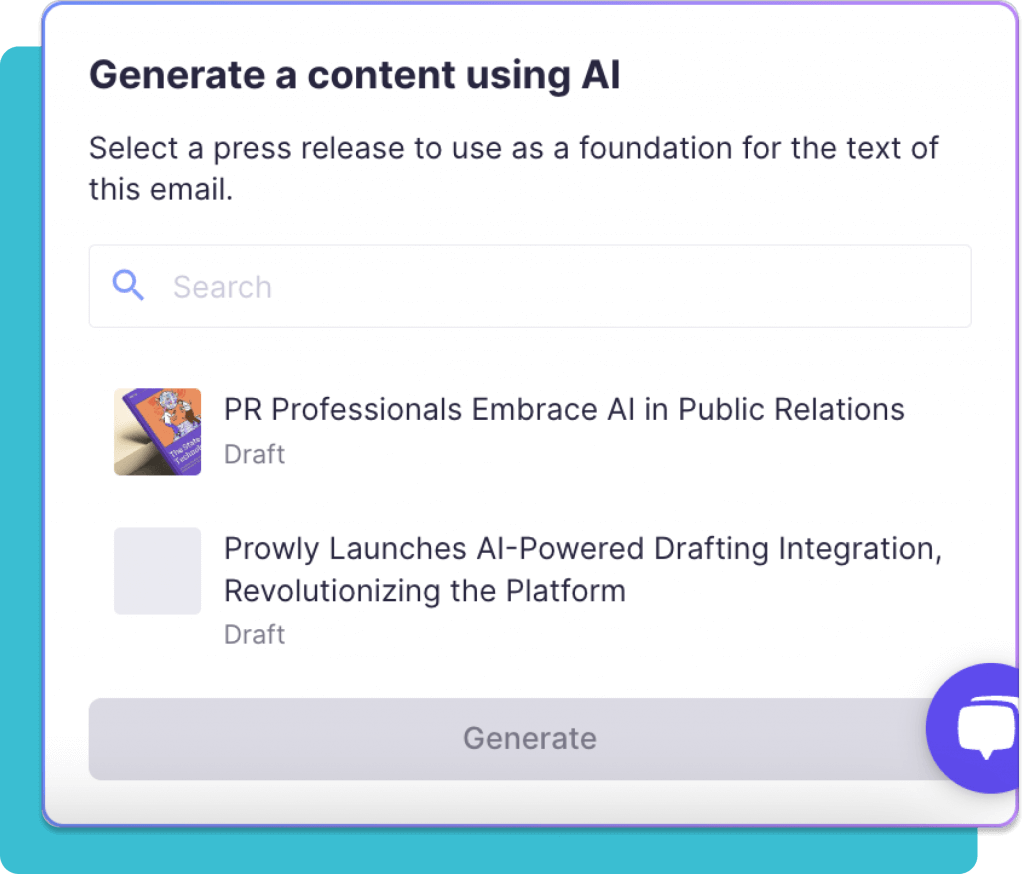
👉🏼 Generating subject line suggestions
Subject Line and the Preview Text Generator can help you craft attention-catching messages for professional and effective pitches that won’t be left in a journalist's inbox unopened for a lifetime.
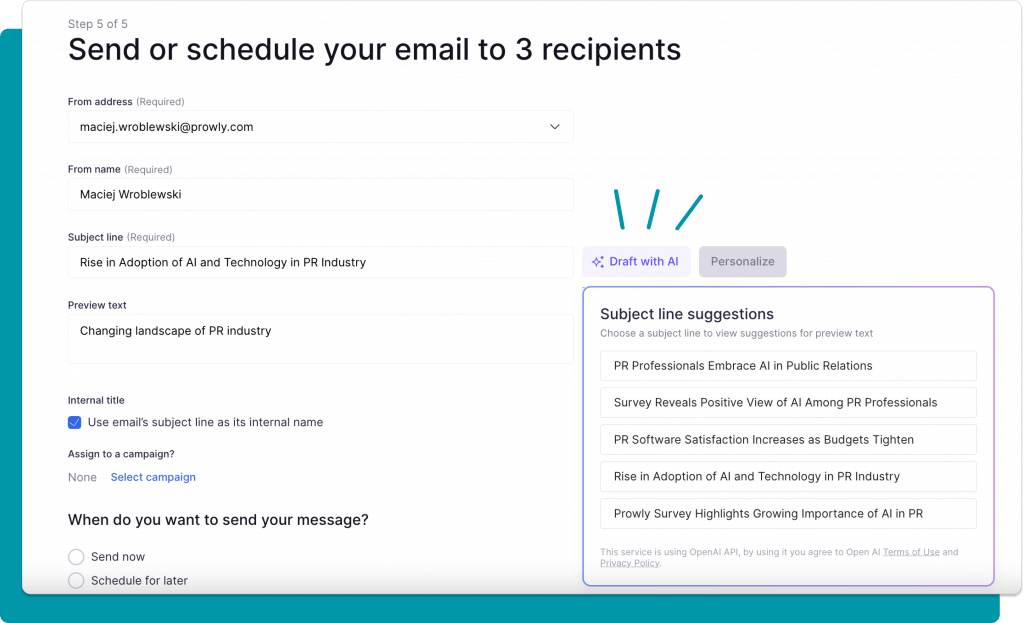
The entire process - writing, finding journalist contacts, and sending emails with suggested content - is seamlessly integrated into one platform. No need to switch tools and tabs, or do any copying and pasting. With fewer distractions, you’ll get better quality outcomes.
How to introduce an ethical AI framework to a PR agency?
Once you’ve decided on the best AI PR agency framework for your agency or team, take clear steps to introduce them. Here are our recommendations for rolling out a framework and the types of guidelines it should include.
#1 Provide clear AI guidance and training
Bring everyone together for training, allow them to ask questions and point out potential challenges. Train them on both guidelines and the basics of using these new AI tools.
#2 Use confidential client information with caution in generative AI tools
Who hasn’t heard of the (in)famous case of Samsung banning ChatGPT among employees after a sensitive code leak? Since it’s better to learn from the mistakes of others, you should keep in mind that, unless an AI tool confirms its platform is closed, anything entered as a prompt may become part of the public sphere. This means there are clear do’s and don’ts to follow:
Do:
✅ Use AI tools to help write press releases that don’t include sensitive or confidential information.
✅ Use it to break writer’s block.
✅ Use it to optimize a press release you have written yourself.
Don’t:
📛 Use it to create a first draft of a press release about a new product.
📛 Use it to draft internal memos for staff.
For example, the best practice we recommend when using generative AI press release creation is to create a press release without sensitive information, then add in the critical details manually at the end.
#3 Take caution while generating AI images
Generating AI images is one of the most exciting features of the technology, but it comes with risk, as copyright protections are still being debated.
At this point, you run both the risk of infringing on a copyright and not getting copyright protection on an AI-produced image.
Image powerhouses like Getty are at the forefront of setting legal regulations here. An example is their legal proceedings against Stability AI.
#4 Double-check every result
We have learned that AI can not only include misinformation in its results but incorrectly name its sources. Double-check any facts presented in AI results to avoid inadvertent plagiarism, copyright infringement, or trademark infringement.
Several authors are already calling out copyright infringement, claiming their texts were used to train AI.
Even with new checker tools being added (like Jasper’s plagiarism checker), we still recommend having a human confirm information.
#5 Be transparent to clients about using AI
The PR Council guidelines recommend being transparent and disclosing the use of AI to your clients.
Disclosure can take place in your PR contract or through conversation. The key is not only to disclose that you use it, but how exactly it is used in your agency. You’ll also want to provide notification that you do not use their confidential information with it.
An example of how you might phrase this: The use of generative AI may be used in our PR process for creative ideation. We never enter sensitive client data into AI tools and all AI content is fact-checked and fully developed into final content with our team’s input.
#6 Be careful when using video or voice-generated AI content
Some will be tempted to use voice or music-generating AI tools to correct a voiceover or build an accompanying piece. This might, however, infringe on the rights of the voiceover talent, musical artists, or composers.
Even Drake and The Weeknd have already found their voices recreated in AI and delivered as new music products.
#7 Create a team review process
Most PR agencies are used to requiring a “second set of eyes” on any written piece, and AI content is no exception.
You may also want to host regular sessions with your team where you review a piece of AI content and discuss any red flags that stand out. Discuss how the content should be revised in its final draft.
#8 Work on real-life diversity, not AI
This guideline is pretty straightforward: diversity in talent needs to happen in real life, not through AI construction. Having an AI tool create or modify photos to show diversity is not only inappropriate but highly unethical.
Questions any AI PR agency should answer
When discussing AI content with your team, you’ll want to train each team member to think through several questions every time they use an AI tool. The questions can be custom made for your team, but some examples include:
- How am I making sure I protect my client’s confidential information?
- How will using an AI tool benefit the final product?
- Am I using AI queries that are free of bias?
Make your framework a work in progress
Your AI PR agency framework of today will look much different in the future. We don’t know exactly how AI will evolve, or what problems may emerge, so keep your framework open for changes.
Start using AI responsibly
“Will AI take over PR?” is the wrong question to be asking at this point. Instead, we should be asking, “What is the future of AI in PR?”
The future looks bright, with AI providing support to PR professionals for the basic levels of PR workflows.
It’s up to PR teams and agencies to act responsibly, creating guidelines and ethical frameworks along the way.
See generative AI in action on PR tasks by trying Prowly free for 7 days.

